How to Recover Deleted GoPro Videos and Photos from an SD Card
Accidentally deleted a GoPro video? Don’t give up yet, it’s a mistake many GoPro enthusiasts have made. The good news is you’ve landed on the right guide. Below, we’ll cover whether it’s possible to recover deleted GoPro videos (and photos too), and walk you through the process using tools built specifically for action cameras.
Let’s jump right into it.
Can You Recover Deleted GoPro Files from an SD Card?
We won’t keep you in suspense, yes, it’s often possible to recover deleted GoPro files from an SD card. When you delete a video or photo, the data isn’t instantly wiped. Instead, the space it occupied is marked as “free,” which means the original file is still there in the background... until something else gets saved over it.
To get a more definitive answer, though, you’ll need to run through a few quick questions:
- Was the file deleted, or was the entire card formatted?
- Was the card used after the files disappeared?
- What’s the condition of the SD card?
Answers to these will give you a solid idea of what you’re working with and whether recovery will work.
For example, if you simply deleted the files and haven’t touched the SD card since, your chances are excellent. That’s the ideal case. But if you kept recording new footage afterward or did a full format, your odds drop fast.
First 5 Things to Do After You Realize You Deleted GoPro Files
No matter your exact scenario, what you do first matters a lot. Follow these 5 steps to give yourself the best shot at recovering your deleted GoPro videos:
- Stop using the SD card immediately
GoPro cameras, especially newer ones like the HERO10, HERO11, and HERO12, record high-bitrate 4K and 5K video. That means new footage can overwrite deleted data fast. Every second counts. Remove the card and do not record anything else. - Power off your GoPro and safely remove the microSD
card
All GoPro models, from the HERO5 Black to the MAX and beyond, use microSD cards (not full-size SD). Pull it out and set it aside until you’re ready to recover. If your camera froze or glitched, turning it off now also avoids further file corruption. - Don’t format the card (even if your GoPro or computer asks you
to)
GoPros support exFAT and FAT32 depending on card size. If your computer says “format before use,” ignore it. Formatting will make things worse. - Use a card reader, not a USB cable to the camera
Plug the microSD card into your computer using a high-quality card reader. This gives recovery tools direct access to the raw data. - (Optional but recommended): Make a full image of the
card
See if your recovery software lets you create a byte-for-byte copy (a disk image) of the SD card. This protects the original card from further stress (especially if it’s showing signs of severe corruption) and gives you a safe copy to scan instead. If anything goes wrong during recovery, you’ll still have the untouched image to fall back on.
Quick reminder. newer GoPros (like HERO10/HERO11 Black) need UHS-3 / V30 rated microSD cards to keep up with high-res, high-frame-rate footage. If you were using a slow or off-brand card, it may explain how the problem started, and it might also mean fragmented files that need extra care to recover.
How to Recover Deleted GoPro Files
Now that you’ve secured your SD card, it’s time to get to work. We’re going to walk you through two recovery tools that are well-suited for GoPro file recovery: Disk Drill and GoPro Recovery (GPR).
Disk Drill is a partner product we trust and recommend, and GoPro Recovery (GPR) is our own tool, purpose-built specifically for GoPro cameras. Starting with version 6, Disk Drill actually became more powerful than GPR in many ways, thanks to its Advanced Video Recovery module. It’s a great choice not just for GoPro footage but also as a universal recovery tool you can use for other data loss situations in the future.
Since Disk Drill is much easier to use and works as a more universal recovery tool, it makes sense to start there.
Method 1: Recover Deleted GoPro Files with Disk Drill
Disk Drill shows great results with FAT32 and exFAT file systems, both of which are commonly used on SD cards in cameras, ideal if you're trying to recover deleted photos from a GoPro camera or recover high-res videos. Most GoPro models format cards as exFAT when they're 64 GB or larger, and FAT32 for smaller ones, so it’s the right fit for any card you’d use in a GoPro, from the HERO8 to the HERO12.
Another reason Disk Drill stands out for GoPro video recovery is its ability to recognize GoPro-specific file signatures. Even in extreme cases where the file system is damaged or completely unreadable, Disk Drill can still scan the raw data.
Here’s what it can detect and recover:
- MP4, MOV, and .360 video files – Whether you shot in 1080p, 4K, or full 5K, Disk Drill handles all these high-resolution formats (including 360-degree footage from GoPro MAX).
- LRV and LRF – These are GoPro’s low-res preview videos.
- RAW photo formats – GPR (GoPro’s RAW format), as well as ARW, CR2, CR3, DNG, NEF, ORF, RAF, RW2, and more.
- WAV – For GoPros that support separate audio tracks or external mic setups.
- THM files – These are thumbnail previews GoPro creates for quick access in its media viewer.
Alright, enough theory, let’s get to practice. Here’s how you can recover deleted GoPro files using Disk Drill, step by step:
- Head over to the official CleverFiles site and download the latest version of Disk Drill for your OS. The site usually auto-detects whether you're on Mac or Windows and gives you the right installer.
- Open it up and follow the prompts.
- Plug the card into a USB card reader. Even if it doesn’t appear in File Explorer (Windows) or Finder (Mac), that’s okay, Disk Drill can still detect it as long as it’s listed in Disk Management or Disk Utility. If you’re unsure, look for the one that matches your card’s size.
- Open Disk Drill, and you’ll see a list of all connected storage devices.
 Find your
GoPro SD card (it’ll probably be listed by its brand name, like SanDisk or
Lexar) or just as a generic storage device. If it has multiple partitions, select
the entire card for a deeper scan.
Find your
GoPro SD card (it’ll probably be listed by its brand name, like SanDisk or
Lexar) or just as a generic storage device. If it has multiple partitions, select
the entire card for a deeper scan.
- Click “Search for lost data” next to your SD card. Disk Drill
will then ask how you want to scan: Universal Scan or Advanced
Camera Recovery.
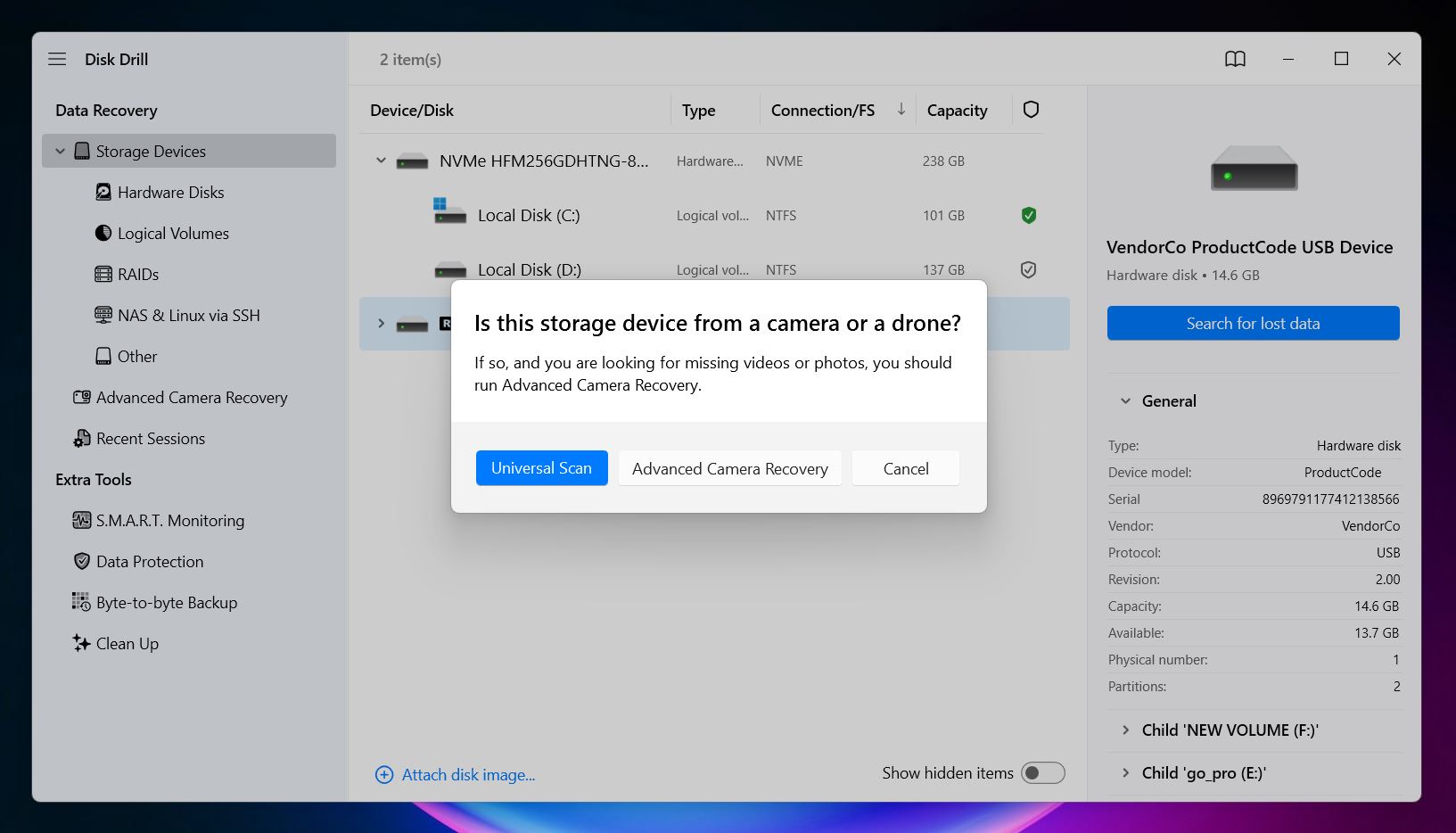 If your footage was deleted in-camera or something
interrupted the recording and the file never showed up, we recommend starting with
Advanced Camera Recovery. And if you don’t find what you’re
looking for on the first try, you can always run another pass using Universal
Scan just to cover all your bases.
If your footage was deleted in-camera or something
interrupted the recording and the file never showed up, we recommend starting with
Advanced Camera Recovery. And if you don’t find what you’re
looking for on the first try, you can always run another pass using Universal
Scan just to cover all your bases.
- Wait for the scan to finish and review results; you can watch the files populate in
real-time or wait for the scan to fully complete before clicking “Review found
items.”
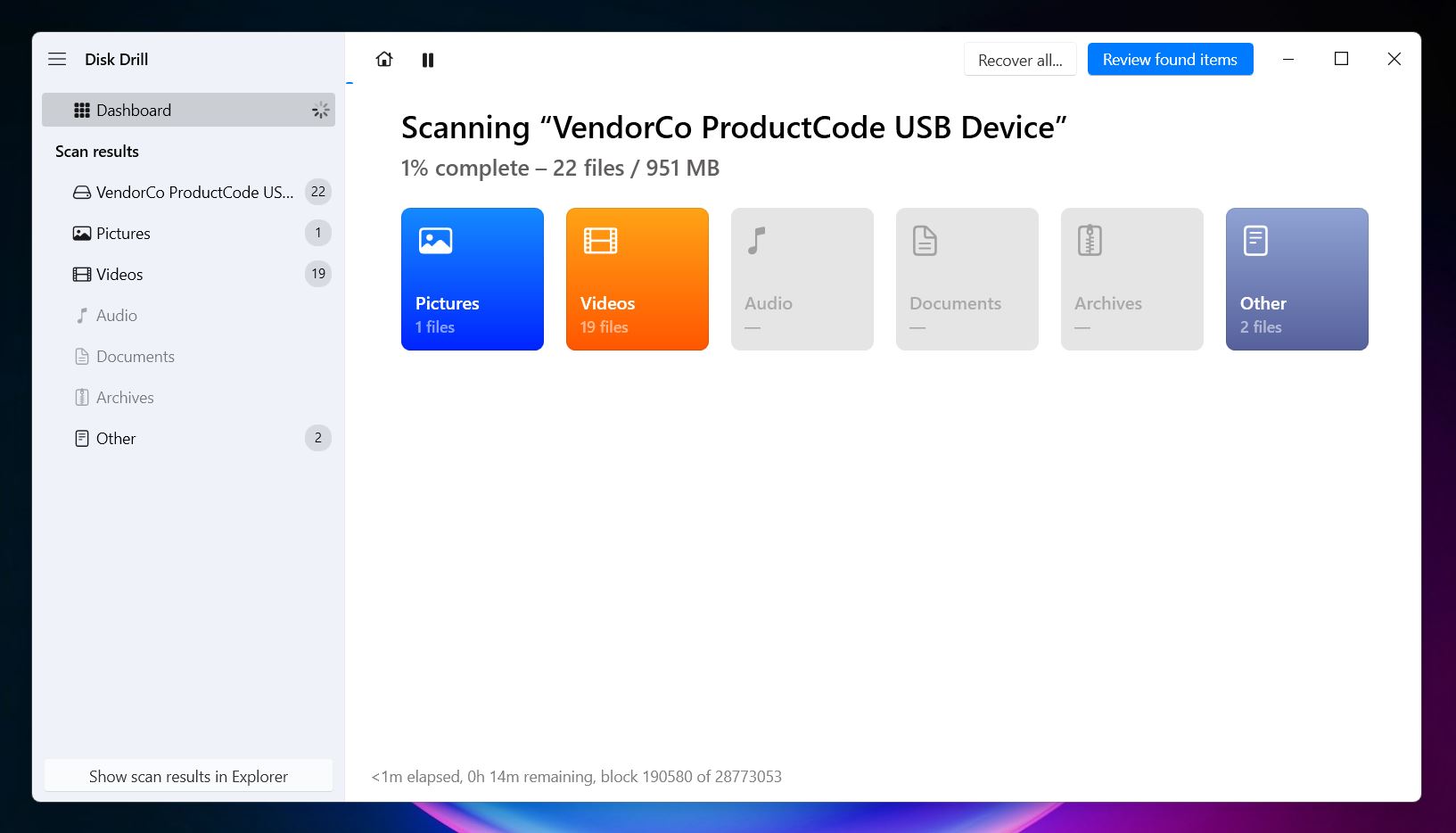
- Once the results are in, Disk Drill sorts files by type: Videos, Pictures, Audio, etc. Use
the sidebar to quickly jump to MP4, AVI, or
JPG files. If you’re looking for something specific, use the search
bar, just type something like “.jpg” if you’re after images only, or
“.mp4” to filter down to GoPro videos.
Bonus tip: Use the preview function (eye icon) to make sure your files look playable. If the thumbnail loads or you can scrub through the video, it’s a 100% sign that the file is intact and should work without any issues. Disk Drill also shows recovery chances - High means the file’s in good shape, Average or Low means it may be damaged or partially overwritten.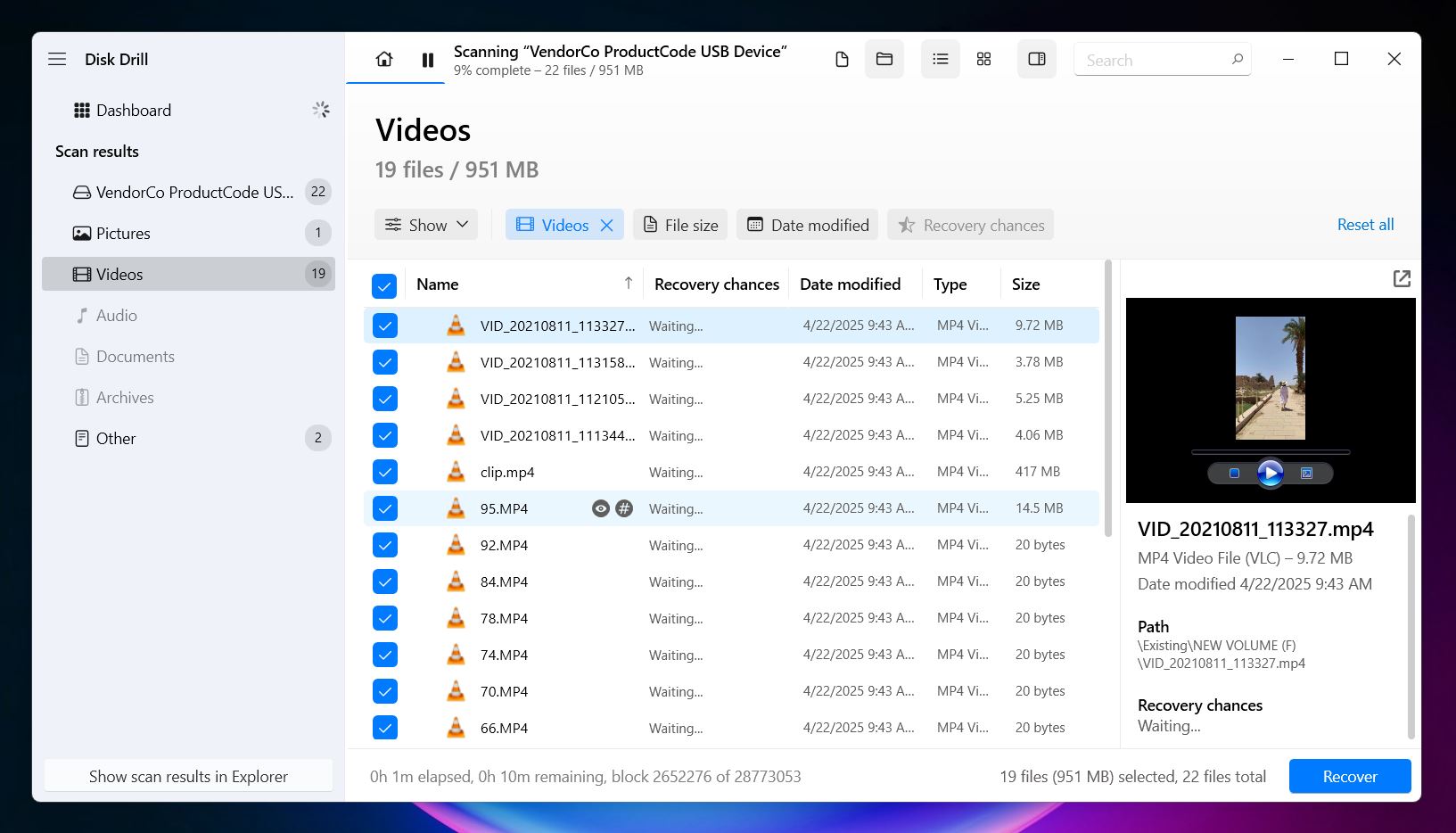
- And finally, check the boxes next to the files you want, click
“Recover,” and choose a destination other than your SD
card (if you save recovered files back to the card, you can overwrite others
still waiting to be recovered). Disk Drill will warn you if you try.
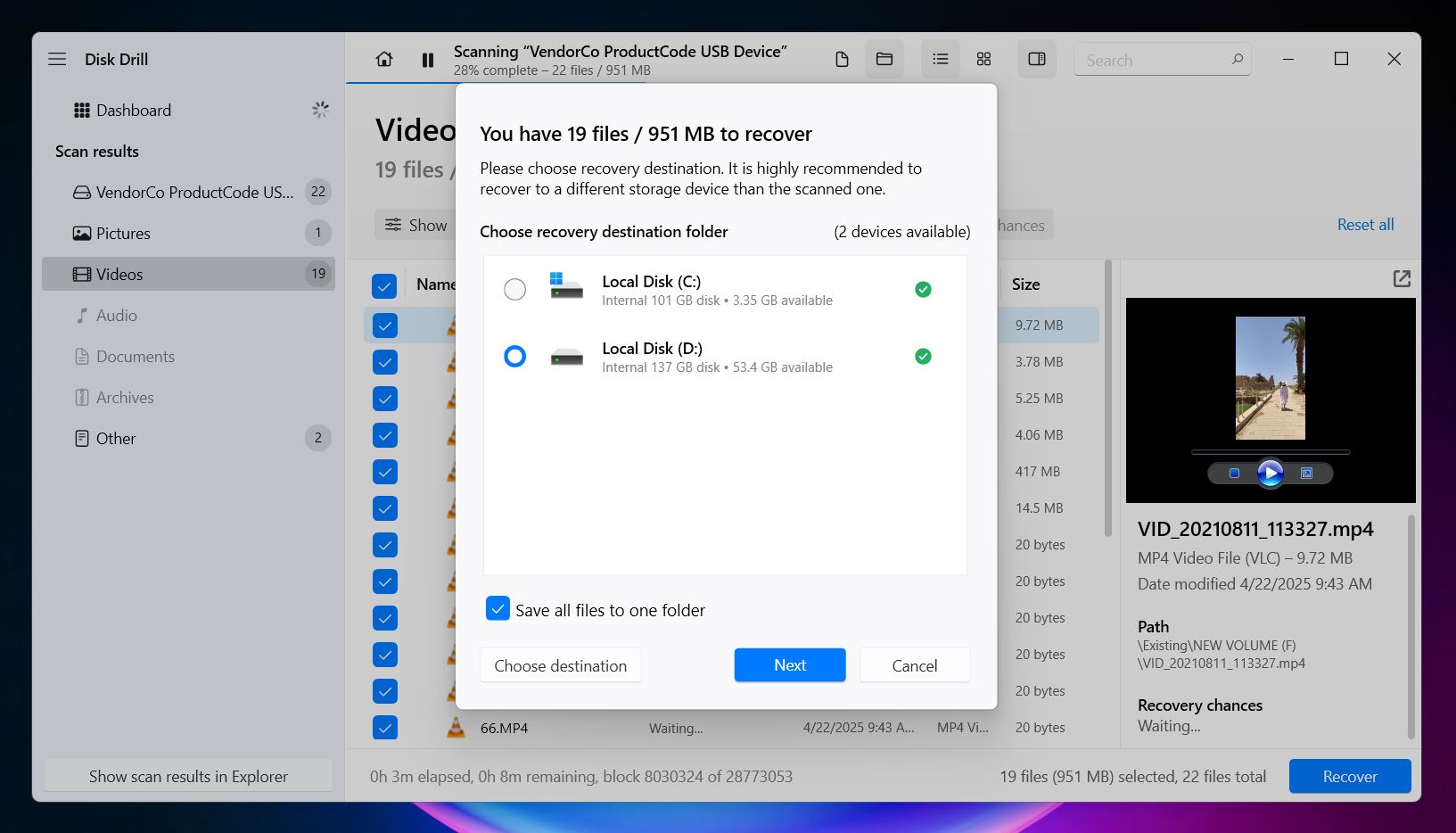 If you’re
using the free version of Disk Drill on Windows, you can recover up to 500 MB of data
without upgrading to PRO. That might be enough for a handful of photos or a couple of
shorter videos. But if you're working with larger files, especially RAW formats like .GPR or
long 4K videos, you’ll likely need to upgrade. The good news is that scanning
isn’t limited, even in the free version, so you can still preview everything before
deciding whether it’s worth buying.
If you’re
using the free version of Disk Drill on Windows, you can recover up to 500 MB of data
without upgrading to PRO. That might be enough for a handful of photos or a couple of
shorter videos. But if you're working with larger files, especially RAW formats like .GPR or
long 4K videos, you’ll likely need to upgrade. The good news is that scanning
isn’t limited, even in the free version, so you can still preview everything before
deciding whether it’s worth buying.
Once the process finishes, you’ll get the option to open the recovery folder and check your files.
Method 2: Recover Deleted GoPro Files with GoPro Recovery (GPR)
Another great option for recovering lost GoPro footage is GoPro Recovery (GPR). It’s a specialized tool we built specifically for camera recovery, and it shines in cases where typical recovery software struggles, especially with fragmented GoPro footage.
Unlike many other general-purpose tools, GPR was designed around how GoPros (and other cameras like Canon and DJI) store video: scattered across the card in dozens or even hundreds of tiny fragments. That’s why some tools recover the file, but it won’t play. GPR knows how to reconstruct those fragments into a single playable video, with both video and audio in sync.
Here’s a quick look at the GoPro models our software currently supports:
- GoPro Hero – The original basic model with straightforward file structure.
- GoPro Hero 3 – First to support separate low and high-resolution video streams (great for recovery).
- GoPro Hero 4 – Improved quality, but with a different approach to storing data—GPR accounts for that.
- GoPro Hero 5 – Introduced 4K recording using H.265 (HEVC), which is more efficient but trickier to recover manually.
- GoPro Hero 6 – Continued HEVC support, added GPS and Wi-Fi metadata streams (GPR handles these during reassembly).
- GoPro Hero 7 – Introduced visual stabilization and loop recording, both create complex file structures.
- GoPro Hero 8 – Features HyperSmooth 2.0 stabilization, creating more file fragments per video.
- GoPro Hero 9 – First with 5K HEVC support and HyperSmooth 3.0, leading to heavier files and more fragmentation.
- GoPro Hero 10 – Higher bitrate 4K and 5K recordings (recovery needs
to stitch more fragments together accurately).
GoPro Hero 11 – Supports individual files larger than 4GB, thanks to refined exFAT support. - GoPro Max 360 – All-around video capture results in multiple video streams—GPR can pull and reconstruct them properly.
Here’s how to retrieve deleted videos from a GoPro using GoPro Recovery (GPR):
- Download the latest version of GPR-64. It’s a Windows-only tool, but many users have reported success running it on macOS via Parallels or on Linux with Wine. The installer is small, lightweight, and installs in under a minute.
- Make sure your Canon or GoPro SD card is connected to the computer through a reliable
reader. Avoid using the camera’s USB cable (it won’t give the software full
access to the memory structure).
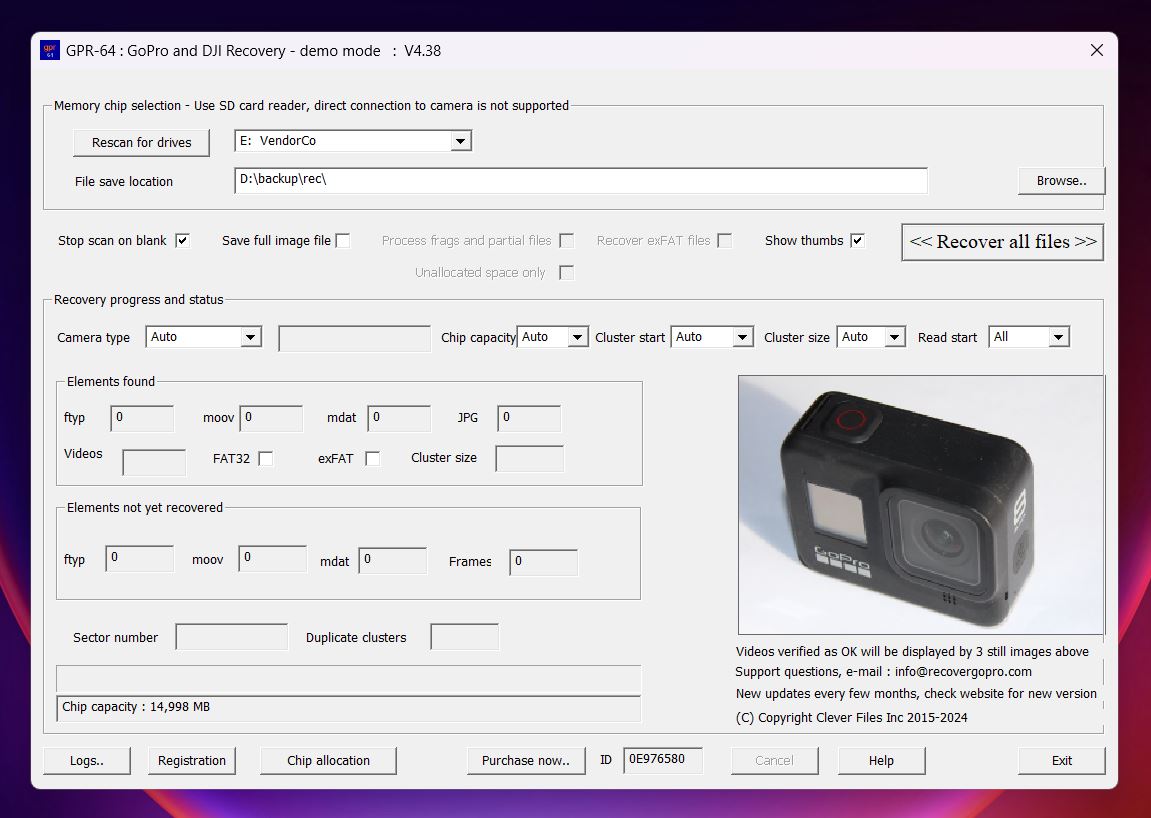
- On the main screen, GPR will list available drives. Look for the one that matches your SD card’s size and drive letter. Then, choose a folder on your computer to store recovered files, don’t save them back to the card, or you might overwrite other recoverable data.
- Click <<Recover all files>> to begin the recovery process.
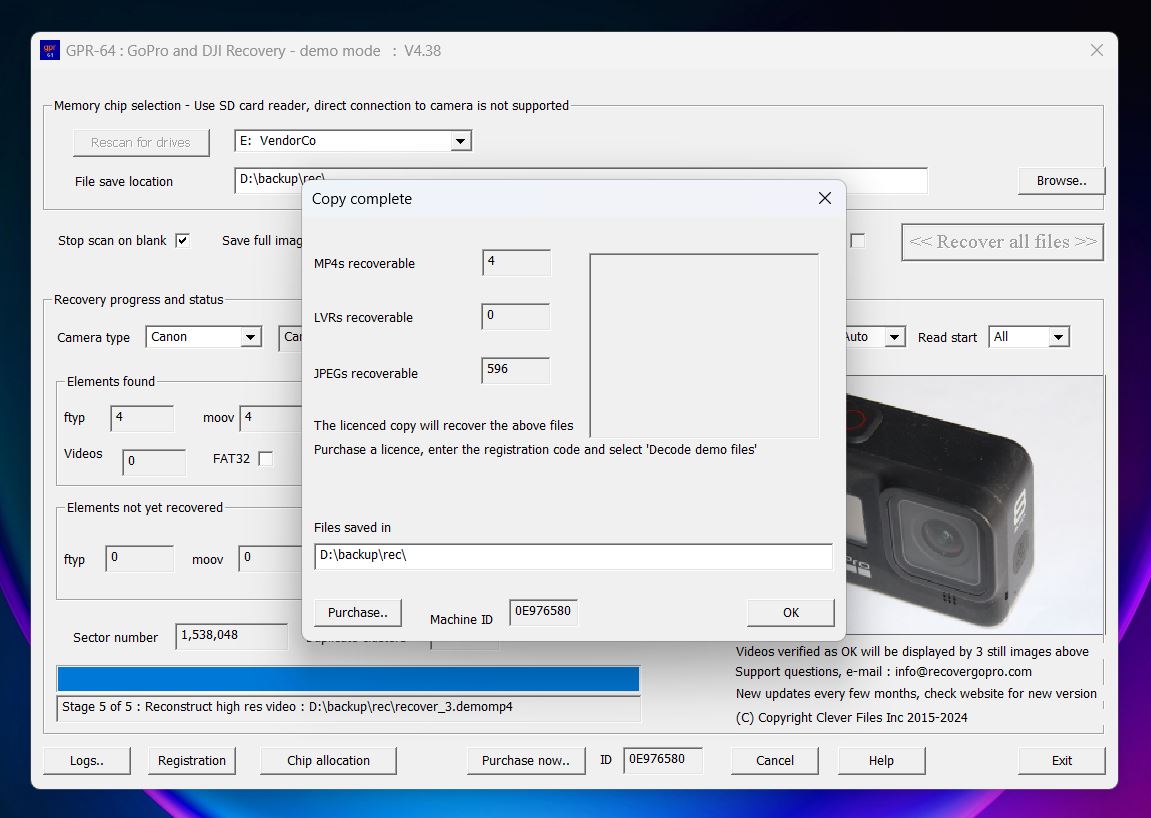
- GPR shows live thumbnail previews as it recovers each file. Even in demo mode (before purchase), you can see which files are working, so you’ll know if the recovery was successful before unlocking full access.
- After the scan, GPR displays a detailed log: filenames, file sizes, dates, how many
fragments were stitched together, and whether each file is verified and playable.

GPR understands the structure, metadata, and quirks of GoPro models, and that’s what makes it an effective tool, even in complex cases.
Unplayable GoPro Footage After Recovery? Read This
Usually, if you follow the steps we covered and use proper tools like Disk Drill, your videos come back in good shape. You preview them, they play, you’re golden. But sometimes it's not that simple. Maybe the video won’t open, or you get no audio, or a “can’t play this file” error.
There are a few reasons this happens:
- Maybe parts were already overwritten.
- If the footage was heavily fragmented or the file system was damaged, there might not be enough pieces left to fully rebuild the file.
- In some cases, the video was already broken before deletion (like from an interrupted recording), and you’re simply restoring a corrupted file.
Here’s something worth knowing: many GoPro cameras have a built-in repair tool, often referred to as the SOS feature. If a recording gets interrupted, say your battery dies mid-shoot, the next time you turn the camera on, it’ll try to fix the video automatically. You’ll see an SOS message or a little bandage icon pop up on the screen, with a prompt to repair the clip.
If that option ever shows up, let the GoPro do its thing. It’s designed to rebuild the video headers and make the file playable. We're not saying that it’ll 100% fix things if your recovered file doesn’t work, but if you ever catch that SOS prompt after a crash or power loss, it might save your clip before things go south. Definitely worth letting it run.
Also, if you’re stuck with a broken file after recovery, there are a few online repair services that specialize in this kind of footage. One worth mentioning is Clever Online Video Repair, a free service that supports GoPro formats and works directly from your browser. You upload the corrupted file (and ideally a healthy sample recorded on the same camera), and it tries to rebuild the damaged structure. It’s quick to try and costs nothing. You can also find more video repair tools and services here.
Final Thoughts
If there’s one thing we’ve learned from helping people recover GoPro footage, it’s that speed matters. The sooner you stop using your SD card after deleting something, the better your odds of getting it back. Seriously. Even one new video can be enough to overwrite what you’re trying to recover.
We want to leave you with a few habits we’ve picked up that might save you the same headache:
- Stick to recommended SD cards. GoPro themselves suggest UHS-I U3 or V30 cards and above. Slower cards can cause recording issues or make file corruption more likely, especially with 4K and 5K footage.
- Always format your card in-camera before using it. Don’t just delete files manually or move things around via computer. The camera optimizes the format for its own use, and it helps avoid weird file system issues.
- It’s tempting to squeeze out one last shot, but if the battery dies mid-recording, you could end up with a corrupted file. Avoid filming on a low battery.
- Never yank the card out while the camera’s on. Turn it off first. We’ve seen so many cases where pulling the card during a write process leads to a completely trashed file system.
- Back up after every session. Whether you’re filming a vacation or a stunt, get that footage off your SD card and onto a computer or cloud drive as soon as you can.
- Keep an eye on your cloud sync settings. Some services (like GoPro’s own Quik cloud) have auto-delete enabled by default. You might think your files are backed up, only to find them missing a few weeks later.
Do all this, and hopefully you won’t need recovery software in the first place. But if you do, you’ll always have this guide to walk you through it.